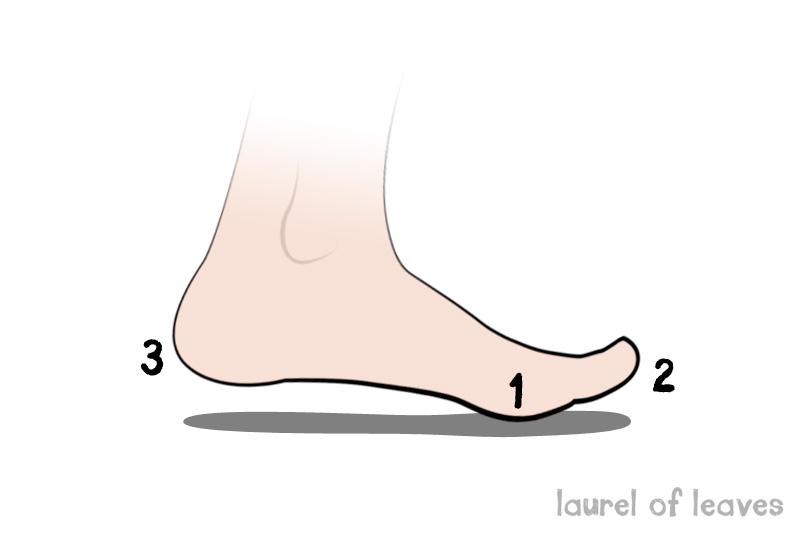The All Important Barefoot Running Landing
Here’s what to do if you want your calves to be writhing in agony tomorrow: Run like a fairy, extending your leg far in front of your body with each step, landing only on your toes. Don’t place your heel on the ground at any point.
Why would you put yourself through the misery of voluntarily holding tension in any part of your body for an extended period of time? Doesn’t that hurt just thinking about it? Yet so many people make that mistake when they first slide on a pair of FiveFingers or simply lose their Nikes. They’ve just heard that the traditional ‘heel strike’ is a no-no and one should utilize a fore- or mid-foot landing instead. But like I said before folks, there’s more to it than that!
Here’s the deal about calf pain during the start of the barefoot running transition. You don’t have to deal with it! It’s not some rite of passage that merits you entrance into an elite barefoot running club. Sure, you might experience soreness in your calves and other parts of your body when learning new techniques. You haven’t been using these muscles for years! It’s only natural to experience some tenderness while you are strengthening those muscles. But Ken Bob Saxton puts it well when he says this:
“Calf pain is not a rite of passage; it is mostly a wrong of technique. If you bend the knees more and learn to allow a heel touch after the ball-of-the-foot landing, you should not suffer much, if any, calf pain.”
There’s that bend in the knees again. Knees=Springs for your body. If you are bending your knees enough it’s almost impossible to tense up your calves. And speaking of not tensing your calves, are you holding tension in your shoulders still? Take a deep breath and repeat it to yourself:
Relax.
Relax.
RELAX.
Relax your shoulders, relax your calves, relax your ankles even. Allow your legs and feet to gently come in for a 3-part landing.
The 3-Part Foot Landing
Rule number one: always land on the ball of your foot. That area of your foot is designed to withstand the load of the entire body meeting the earth, but it’s not meant to stop there.
Secondly, place your toes on the ground, followed by your heel. Practice this in slow motion to get a feel for the rhythm. But also realize that when brought up to full speed it might seem like a flat-footed landing. It’s a very subtle separation of the foot, but it’s important to develop. Land on the ball of the foot first, then the toes and the heel (sometimes the heel will land before the toes depending on the terrain, like on a hilly forest trail for instance).
Leaving on Jet Plane
If you’ll indulge me an analogy, think of your foot as an airplane. You don’t want to nosedive into the runway then slam the tail end of the plane into the ground. Your passengers would most certainly never fly with your airline again after such a rough landing.
As your foot comes down for a landing, tilt your foot up so it is closer to parallel with the ground. Let it glide in for a smooth landing. Place your heel on the ground next, relaxing your ankles & calves and letting your knees sink down lower to absorb even more of the impact. (To avoid scuffing your toes on the ground during this process, give them an ever so slight lift just before landing. This will also help avoid blisters on your toes.)
This Week’s Homework
Time for some practice! This week, practice the 3-part landing of the foot in slow motion while standing in place. Gradually work your way up to a more normal speed. Think gentle and relaxed thoughts.
Also don’t forget to keep your head up, swing your arms vertically, and bend your knees.
Lose the Shoes Series Posts
- Lose the Shoes & Keep Your Head Up
- Lose the Shoes & RELAX Your Shoulders
- Lose the Shoes & Bend Your Knees
- The All-Important Barefoot Running Landing
- Lose the Shoes & Feel Like You’re Falling
- Conserve Energy When Running Barefoot
- Training Plan for a Barefoot 5K
This post is linked to Monday Mania, Simple Lives Thursday
Comments are closed.


Paige
June 10, 2014 at 9:56 pmMy doctor recommended a golf ball muscle roller which i use before and after i run, wow what a difference!! Everyone runner needs one,night and day difference! http://zzathletics.com/Golf-Ball-Muscle-Roller-Massager-GBMR1.htm
Lori Winter
June 16, 2014 at 2:12 pmYes! I’ve been using a lacrosse ball to help roll out the muscles in my feet. Super important! ;)